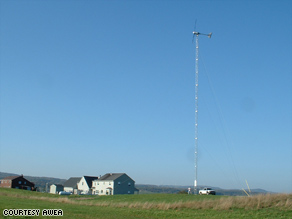Wind power concerns many
Residents say plans are moving too fast
ROCKPORT, Maine — Offshore wind power may have the capacity to help the state free itself from its dependence on foreign oil, but plenty of Mainers have concerns as well as hopes about its potential.
More than 70 people gathered Tuesday night at the Samoset Resort for the last in a series of information sessions about several proposed test sites for offshore wind power generation held throughout September along the Maine coast. Many of them, including Margaret Schuler of Edgecomb, shared their opinions with a panel of experts from the University of Maine, the state Environmental Protection Agency, the Marine Resources and Conservation departments and the state geologist.
“Why would we lay waste to some of our best and most beautiful areas for a test site?” she asked.
After a legislative mandate, the state has identified seven areas as possible demonstration sites for testing wind power equipment. All are located in state-controlled waters, less than three miles off the coast, and have waters more than 200 feet deep.
Wind speeds are higher farther offshore, panelists said, and 200 feet is as deep as fixed-based turbines can be.
The proposed sites are located off Metinic Island, Matinicus, Monhegan, Isle au Haut, Cutler, Jonesport, Damariscove Island and Boon Island. Damariscove is off Boothbay Harbor in Lincoln County, and Boon Island is off Cape Neddick in York County.
By mid-October, the state will publish a draft list of as many as five demonstration areas along the coast, and the final decision of where to construct one or more is expected to be made in mid-December.
The panel of experts explained to the sometimes skeptical crowd that the turbine test sites would be financed, maintained and ultimately removed by private companies, and that each would contain no more than two demonstration turbines. They also tried to alleviate concerns that the benefits of wind power ultimately might bypass the state — enriching corporations, altering the landscape and possibly endangering wildlife.
“Once the turbines are up, the price of fuel is zero,” said panelist Beth Nagusky, director of the Office of Innovation and Assistance at the Maine Department of Environmental Protection. “[Wind power] gets us away from the volatility of the market.”
Smaller-scale prototype floating turbines could be in place as soon as the spring of 2011, said panelist Jake Ward of the University of Maine.
Participants expressed worries about interference with lobster fishing, the effect on seabirds, whales, fish and butterflies, the impact on Maine’s dark night skies and damage to the scenic nature of the coast. Several people seemed concerned that the state is moving too quickly as it prepares to construct the test sites.
“We do have quite a large database about these areas,” Kathleen Lyden of the Maine State Planning Office said in response. “It’s not that we’re operating without information.”
Ward said many university studies of the Gulf of Maine have been completed over the last 30 years, and that the test sites will provide an opportunity to do “a lot more analysis” of the area.
Elizabeth Dickerson, a Rockland city councilor, wondered how many jobs would be created through the test site construction process.
Ward told her that there likely would be “dozens” of jobs related to any test site, and “thousands” related to any wind energy project.
“There will be about 16 jobs per $1 million invested,” Ward said.
Jim Mays of Rockport shared his opinion that time and money would be better spent on gathering wind and wave data about 20 miles offshore, where the “real wind” is.
“Knowing the exact wind climate out there is extremely important, so designers won’t overbuild and they won’t underbuild,” he said. “It’s the first step in what I hope will be responsible development of our wind resource.”
Lobsterman Ryan Post, who fishes near Metinic Island, said that while he sees development of offshore wind power as a “great opportunity,” lobstermen affected by barges and construction in their fishing grounds have to be compensated.
“If you bring in four or five tugs through thousands of lobster traps, it’s going to be devastating. Lobstermen are being pushed aside here,” he said.
But Diane Messer of Liberty aimed to put concerns into perspective.
“We don’t have to have a really distant memory to think back to last winter,” she said. “You can be certain that the price of fuel will go back up again, significantly. And we’re going to be a lot more interested in wind. Let’s get started, let’s get the process going, and let’s stay involved.”
Source: Bangor Daily News
Found Article on Twitter.










Seattle Times | Dave Burdick | March 11, 2009 08:04 AM